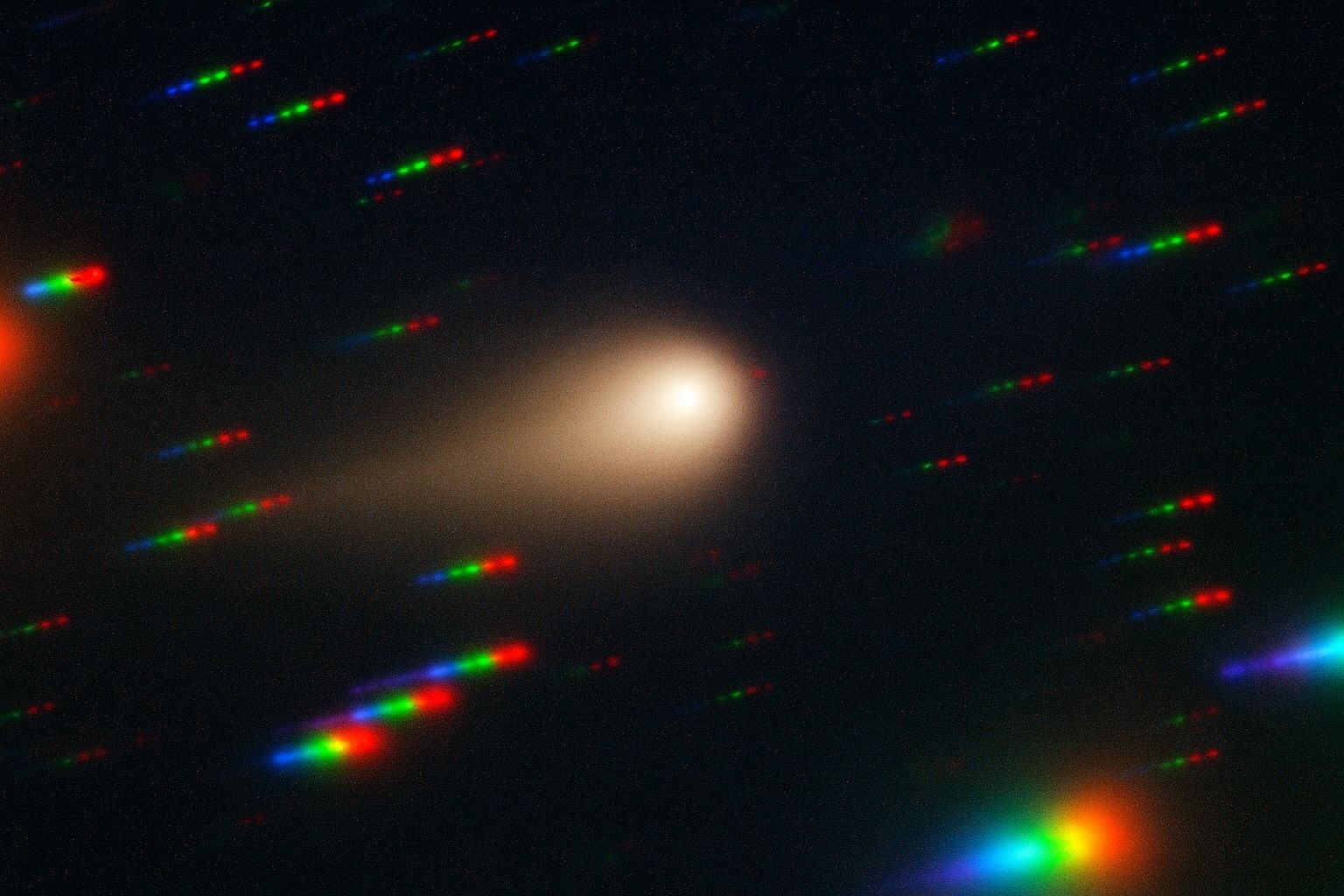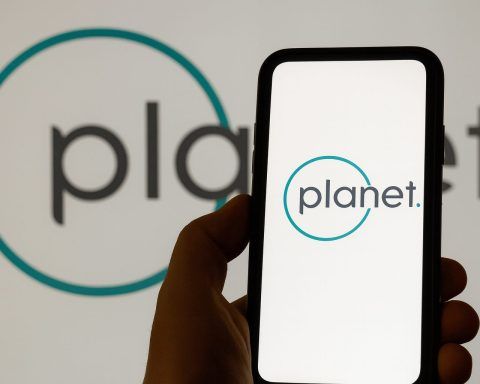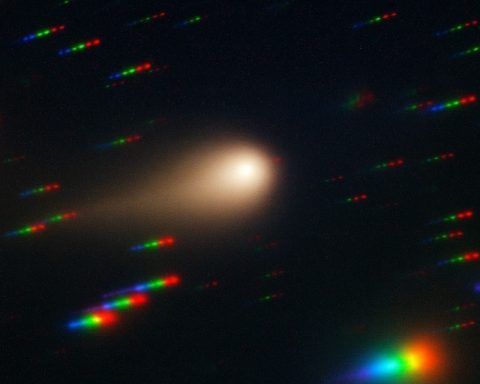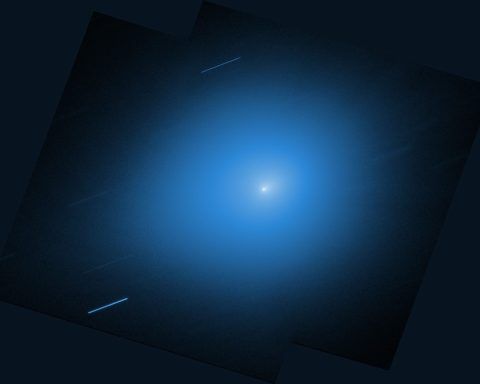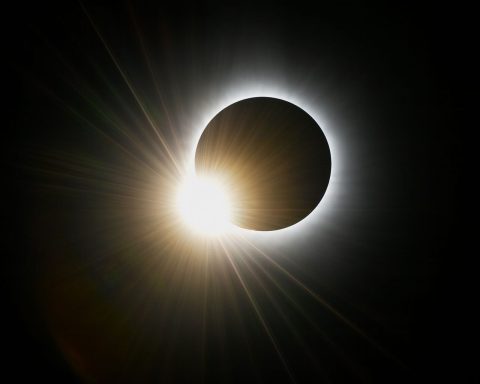- Third Interstellar Visitor: Comet 3I/ATLAS is only the third known object from beyond our Solar System, following 2017’s
1I/ʻOumuamuaand 2019’s2I/Borisov[1]. It was first spotted on July 1, 2025 by the NASA-funded ATLAS survey telescope in Chile. Its sharply hyperbolic orbit (eccentricity ≈ 6.2) immediately flagged it as an interstellar interloper [2]. - Sun Encounter in Oct 2025: 3I/ATLAS reached perihelion (closest point to the Sun) around October 29–30, 2025, coming within ~1.36 AU of the Sun (inside Mars’s orbit) [3]. During perihelion it was on the far side of the Sun from Earth (lost in solar glare), so ground observers couldn’t see it [4]. Its closest approach to Earth will be ~1.8 AU (270 million km) in December 2025, posing no threat and remaining far too faint to see with the naked eye [5].
- Blistering Speed: This comet is hurtleling through the inner Solar System at roughly 58 km/s (~130,000 mph) [6]. Such an extreme velocity – far above typical comet speeds – means it is on an open escape trajectory, a clear signature of interstellar origin [7]. At perihelion it accelerated to over 68 km/s relative to the Sun, faster than any bound comet would travel [8] [9].
- Record Size: Early observations suggest 3I/ATLAS may be one of the largest interstellar objects detected so far. Its solid nucleus could span a few kilometers across [10] – vastly bigger than
ʻOumuamua(~100 m) and larger even than Borisov (~1 km). The Hubble Space Telescope set an upper limit of ~5.6 km diameter for the nucleus [11]. This would make 3I/ATLAS a giant among known interstellar wanderers. - Ancient “Time Capsule”: Based on its galactic trajectory, astronomers think 3I/ATLAS likely hails from the Milky Way’s ancient thick disk of stars [12]. It could be 7–10 billion years old, possibly the oldest comet ever observed (on the order of 3 billion years older than our 4.6 billion-year-old Solar System) [13] [14]. In other words, this comet may have formed long before our Sun, preserving primordial material from a bygone cosmic era [15].
- Unusual Activity: Even far from the Sun, 3I/ATLAS has been surprisingly active. NASA’s Swift space telescope detected it spewing water vapor at ~40 kg per second – “roughly the output of a fire hose running at full blast” – when it was nearly 3 AU from the Sun [16]. Such copious water outgassing at that distance (about three times farther than Earth) is highly unusual; most comets stay quiet so far out. The strong ultraviolet signal from water’s byproduct (OH) suggests sunlight was heating icy grains released from the nucleus, causing a remote “steam” plume [17].
- Odd Chemistry: Spectra reveal an atypical composition. 3I/ATLAS’s coma is rich in CO₂ but low in CO, implying it “was well baked and boiled” in its original star system, having lost its most volatile ices long ago [18]. Scientists also detected cyanide gas and an unexpected abundance of nickel vapor in the comet’s gas [19] – nickel is rarely seen in cometary comas at such distances. Researchers suspect it may be carried in the form of nickel carbonyl (Ni(CO)4), a volatile nickel compound that breaks apart under sunlight [20]. This bizarre chemistry is offering new clues to 3I/ATLAS’s makeup and the conditions of its home system.
- Global Observation Campaign: Telescopes worldwide – and even off-world – have mobilized to study 3I/ATLAS. Both Hubble and the James Webb Space Telescope (JWST) have observed it [21]. Large ground observatories (Gemini South, the VLT, etc.) have imaged its fuzzy coma and nascent tail. Even spacecraft near other planets joined in: in early October, ESA’s ExoMars Trace Gas Orbiter snapped photos of 3I/ATLAS from Mars orbit ~30 million km away [22]. Coming up, ESA’s JUICE probe (near Jupiter) and NASA’s Lucy and Psyche spacecraft (in the inner Solar System) planned to watch 3I/ATLAS around perihelion from unique vantage points [23] [24].
- Intense Scientific Interest: NASA, ESA, and astronomers worldwide are eager to examine this rare visitor for insights into other star systems. As one researcher put it, each interstellar object is like “a note from another planetary system,” carrying clues about the chemical building blocks around other stars [25]. 3I/ATLAS offers a chance to compare its materials and behavior to comets born in our own Solar System – potentially illuminating how planetesimals form across the galaxy [26] [27].
- No Threat – and No “Aliens”: 3I/ATLAS will not come closer than ~1.8 AU to Earth [28], and poses zero danger. Though its interstellar origin and odd traits have sparked some alien spacecraft speculation in media, experts stress there is no evidence of anything artificial. “3I/ATLAS is most likely a comet of natural origin,” says Harvard astronomer Avi Loeb (who nonetheless ranks it 4/10 on his speculative “Loeb scale” of technological signs) [29]. Aside from coincidental curiosities in its trajectory, scientists have observed nothing that defies a natural comet’s behavior [30] – the real excitement is in what this cosmic visitor can teach us, not in sci-fi theories.
Discovery and Designation
Comet 3I/ATLAS was discovered on July 1, 2025 by the Asteroid Terrestrial-impact Last Alert System (ATLAS) survey telescope at Río Hurtado, Chile [31]. ATLAS – a NASA-funded sky survey designed to spot incoming asteroids – detected a faint magnitude ~18 object moving against the starry background [32]. Initially catalogued as C/2025 N1 (ATLAS) under comet naming conventions, the object raised immediate excitement because its orbit did not appear bound to the Sun [33]. Within days, astronomers determined the new comet was on a highly hyperbolic trajectory, not a closed ellipse like ordinary comets. In August 2025 the International Astronomical Union confirmed its interstellar nature and redesignated it 3I/ATLAS, marking it as the third interstellar object ever observed (the “3I” prefix) [34]. This celestial visitor is sometimes also referred to by its survey designation “A11pl3Z,” but the name 3I/ATLAS reflects its extraordinary status beyond the Solar System.
“This is an object from a part of the galaxy we’ve never seen up close before.” – Astronomer Matthew Hopkins, University of Oxford [35]
The discovery of 3I/ATLAS came nearly six years after the last interstellar interloper, 2I/Borisov, and astronomers immediately recognized the scientific opportunity. ATLAS’s find was serendipitous – the survey’s goal is protecting Earth, yet it managed to catch a cosmic traveler likely older than our planet by billions of years. “We think there’s a two-thirds chance this comet is older than the Solar System, and that it’s been drifting through interstellar space ever since,” noted Professor Chris Lintott, a co-discoverer, highlighting the object’s potential antiquity [36]. The chance to study such an ancient “time capsule” from another star system up close set the astronomy community abuzz.
Why 3I/ATLAS Is Considered Interstellar
3I/ATLAS earned its interstellar pedigree purely from its orbit dynamics. Unlike comets that originate in our Oort Cloud and follow elongated but bound orbits around the Sun, this object follows an unbound path that will carry it back out into interstellar space. Calculations show an eccentricity of about 6.14 – an enormously hyperbolic orbit (any eccentricity above 1 indicates an open escape trajectory) [37]. In fact, 3I/ATLAS’s orbit is the most extreme of the three known interstellar objects, meaning it is not captured by the Sun’s gravity at all.
The comet’s velocity is another giveaway. Long before reaching the inner Solar System, 3I/ATLAS was already moving faster than the Sun’s escape velocity. Its hyperbolic excess speed is about 58 km/s – even at infinite distance it would still be moving ~58,000 m/s relative to the Sun [38]. By contrast, a comet bound to the Sun might crawl at only a few km/s in the outer reaches. “Its extreme velocity and open, escape trajectory are clear signatures of an interstellar origin” [39], as one report noted. Essentially, 3I/ATLAS is not gravitationally tethered to our star; it came in from interstellar space and will depart back to the void.
Astronomers verified that no planetary encounter could have flung the object onto such an orbit – its path doesn’t trace back to a likely Solar System source. Instead, projections of its incoming trajectory suggest it descended from far above the ecliptic plane on a retrograde incline (~175° to the Sun’s equator) [40]. It wasn’t born in our Sun’s protoplanetary disk; rather, it’s an interstellar vagabond passing through our neighborhood on a one-time visit [41]. This is why it carries the “I” (Interstellar) designation in its name, joining the very exclusive club of extrasolar visitors.
Orbital Trajectory and Comparison to 1I/ʻOumuamua & 2I/Borisov
After entering the Solar System, 3I/ATLAS followed a steep inbound path. It approached the inner system from the direction of the constellation Serpens (near the northern galactic hemisphere) according to preliminary orbit solutions, though pinning an exact star of origin is nearly impossible. The comet crossed the orbital plane going opposite the direction of the planets (retrograde motion) [42], which helped keep it away from major planetary encounters. On October 3, 2025, it passed about 0.19 AU from Mars – essentially a close flyby of the Red Planet at ~28 million km distance [43]. It then dived toward perihelion just outside Earth’s orbit, reaching closest approach to the Sun (~1.35 AU) on October 29, 2025 [44]. After whipping around the Sun, 3I/ATLAS is now on its way back out: it will cross Jupiter’s orbit by March 2026 and eventually head off toward the constellation Cetus, fading from view [45] [46]. Unlike periodic comets, it will never return; this is a one-way journey past the Sun.
In many ways 3I/ATLAS’s brief visit invites comparison to its two famous predecessors:
- 1I/ʻOumuamua (2017): The first interstellar object surprised astronomers as a small (~100–200 m) tumbling body with no visible coma or tail. It sped through on a highly hyperbolic path (e ≈ 1.2) and was only detected after it had already passed the Sun. ʻOumuamua’s lack of outgassing, odd elongated shape, and slight non-gravitational acceleration sparked intense debate and even theories of alien technology. By contrast, 3I/ATLAS is an active comet, not a barren rock – it has readily produced gas and dust, making it easier to study chemically. Also, 3I/ATLAS is much larger (potentially kilometers wide vs. ʻOumuamua’s tens of meters) [47]. One thing both share is extreme speed; however, 3I/ATLAS’s velocity is even higher, reflecting perhaps a faster ejection from its home system or a different galactic orbit. Notably, 3I/ATLAS’s huge mass (millions of times greater than ʻOumuamua’s) means it carries a richer inventory of material to analyze [48].
- 2I/Borisov (2019): In contrast to ʻOumuamua, Borisov was a true comet in appearance – discovered approaching the Sun with a visible coma and tail. Borisov’s composition turned out to resemble typical Oort Cloud comets, though it had an unusually high carbon monoxide content. With an estimated diameter of ~0.5–1 km, 2I/Borisov was the largest interstellar object until now. Comet 3I/ATLAS appears to dwarf Borisov, possibly by a factor of several in size [49]. Borisov’s orbit (e ≈ 3.4) was quite hyperbolic but less steep than ATLAS’s; it came in near the ecliptic plane, whereas 3I/ATLAS dove in at a sharp angle [50]. Both Borisov and ATLAS showed common cometary volatiles (water, cyanide, etc.), yet Borisov was rich in CO whereas ATLAS is relatively deficient in CO [51]. Each interstellar comet seems to have its own chemical “fingerprint.” As astrophysicist Zexi Xing remarked, “ʻOumuamua was dry, Borisov was rich in carbon monoxide, and now ATLAS is giving up water at a distance we didn’t expect. Each one is rewriting what we thought we knew about how planets and comets form around stars.” [52] Together, these three visitors demonstrate a striking diversity in the building blocks from other star systems.
Despite their differences, all three interstellar objects underscore how much remains to be discovered about planet formation beyond our Sun. They likely originate from very different stellar environments – ʻOumuamua from perhaps a nearby young star cluster, Borisov from a Sun-like star’s outer disk, and ATLAS potentially from an ancient star system in the Milky Way’s distant regions [53] [54]. “Of those known so far, our statistical method suggests 3I/ATLAS is very likely to be the oldest comet we have ever seen,” noted Matthew Hopkins, who studied its galactic orbit [55] [56]. If 3I/ATLAS indeed formed around a long-lived thick-disk star, its constitution could reflect cosmic conditions billions of years earlier than the Sun’s birth. Each new interstellar visitor is thus a unique scientific gift – a small sample of a faraway system, delivered free of charge to our cosmic doorstep.
Scientific Significance and Observation Campaigns
The appearance of 3I/ATLAS in 2025 has been met with an unprecedented global observation campaign. Recognizing the comet as a one-time visitor from another star, scientists scrambled to gather as much data as possible during the few months it would be detectable. Practically every major telescope that could aim at 3I/ATLAS has done so, in a coordinated effort spanning multiple continents and space-based observatories [57].
NASA’s involvement began with discovery (the ATLAS project is NASA-funded) and quickly ramped up. The Neil Gehrels Swift Observatory was one of the first space telescopes to target 3I/ATLAS, detecting the telltale ultraviolet glow of hydroxyl (OH) in July–August 2025 – a byproduct of water vapor – marking the first-ever detection of water from an interstellar object [58] [59]. “Detecting water…is a major breakthrough for understanding how interstellar comets evolve,” said Swift team lead Dennis Bodewits [60]. It means astronomers can apply the same yardstick of water-driven activity to 3I/ATLAS as they do to homegrown comets, enabling direct comparisons across planetary systems [61]. The Swift result was truly striking: it found that 3I/ATLAS was releasing water even when nearly 3 AU from the Sun [62]. At that distance, most comets are too cold for water ice to sublimate, so this suggested unusual processes at work (like icy grains being heated). The measured water production, about 40 kg/s, indicated a significant reserve of ice in the nucleus or its ejected debris [63]. This discovery, hailed as a “major breakthrough” by NASA and featured in BBC Sky at Night, was made possible only by Swift’s ultraviolet eyes above Earth’s atmosphere [64] [65].
Meanwhile, the Hubble Space Telescope captured high-resolution images of 3I/ATLAS as early as July 2025, when the comet was ~277 million miles from Earth [66]. Hubble’s data helped constrain the nucleus size (setting the ~5.6 km upper limit) and showed a bright fuzzy coma, confirming the object’s active nature [67]. As 3I/ATLAS neared the Sun, the coma grew and a faint tail developed. Observers even reported an unusual sunward-pointing jet or “anti-tail” in mid-2025 [68], likely due to dust grains aligned in the comet’s orbital plane.
The new flagship James Webb Space Telescope (JWST) also took an early look. In September 2025, JWST’s infrared spectrometers analyzed 3I/ATLAS’s coma and found an unexpected chemical mix: carbon dioxide was the dominant gas, with relatively little carbon monoxide, and only a small fraction of water vapor [69]. This differs from typical Solar System comets where water is usually most abundant near Sun, and suggests 3I/ATLAS either formed in a cold environment that favored CO₂ ice or it lost its more volatile CO and water ices over eons in space [70]. JWST’s superb sensitivity also detected trace species like carbonyl sulfide (COS) and confirmed the presence of familiar cometary gases CN and C₂ [71]. Intriguingly, both JWST and ground-based telescopes (like the European Southern Observatory’s VLT) picked up nickel vapor in the comet’s coma [72]. Normally, metals like nickel and iron only appear in comet comas when very close to the Sun, but 3I/ATLAS showed Ni far out, hinting at exotic compounds (such as nickel carbonyl) releasing it [73]. Every new dataset added a piece to the puzzle of what materials this interstellar time capsule carries.
On the ground, many national observatories joined in. For example, Gemini South in Chile produced a color image of 3I/ATLAS in late August 2025, showing a spherical coma with a pale greenish hue (often from diatomic carbon gas) [74]. The Very Large Telescope in Chile and other facilities conducted spectroscopic studies to inventory the comet’s gases and dust. Amateur astronomers with large backyard telescopes also tried their hand, though by all accounts 3I/ATLAS never got brighter than around magnitude 12, making it a challenging object even for experienced astro-photographers [75].
Uniquely, spacecraft around other planets contributed to the observing campaign. Because 3I/ATLAS went behind the Sun relative to Earth near perihelion (making it unobservable from Earth-based telescopes for weeks) [76], scientists turned to probes at Mars and elsewhere that had a better viewing angle. On October 3, 2025, as 3I/ATLAS made its closest pass by Mars, ESA’s Mars Express and ExoMars Trace Gas Orbiter successfully photographed the comet from ~30 million km away [77] [78]. In those images, 3I/ATLAS appeared as a tiny fuzzy dot against the stars – the coma was visible, though the nucleus itself was too small and distant to resolve [79]. It was the first time a comet from another star was observed from a planet other than Earth. Encouraged by that success, mission teams planned further observations: NASA’s Lucy spacecraft (en route to Jupiter’s Trojan asteroids) and the newly launched Psyche probe (in cruise between Earth and Mars) both scheduled pointings at 3I/ATLAS around the late-October perihelion [80]. ESA’s JUICE spacecraft, although the closest to the comet around that time, had to use its antenna as a sunshield and thus will only send back its 3I/ATLAS data in February 2026 [81]. Still, these efforts mark an extraordinary multi-vantage-point campaign – humanity’s robotic envoys around the Solar System all teaming up to spy on an interstellar visitor.
Beyond immediate observations, the scientific significance of 3I/ATLAS is profound. Here is an ancient fragment of another star’s protoplanetary disk, possibly older than any comet we’ve studied, passing through our Solar System and offering to divulge its secrets. By comparing 3I/ATLAS’s composition to that of comets native to our Solar System, researchers can test theories of planet formation across different stellar populations. For instance, the fact that 3I/ATLAS is so CO₂-rich and water-poor (relative to most comets here) could mean it formed in a region of its home system with a different temperature profile, or perhaps around a star with distinct chemistry [82] [83]. Its very presence also bolsters estimates that interstellar objects are more common than previously thought – some scientists now suggest “there’s almost always one within the solar system” at any given time, just usually too faint to notice [84] [85]. The upcoming Vera Rubin Observatory, once operational, is expected to detect many more such visitors, building on what 3I/ATLAS is teaching us.
Finally, 3I/ATLAS’s visit has rejuvenated discussions of sending a space mission to an interstellar object. While no probe could be launched in time to chase 3I/ATLAS, both NASA and ESA have concepts on the table. ESA’s planned Comet Interceptor mission (launching 2029) will wait at the ready in space to intercept a fresh incoming comet – possibly even an interstellar one – if the opportunity arises [86] [87]. “When Comet Interceptor was selected in 2019, we only knew of one interstellar object – 1I/ʻOumuamua. Since then, two more such objects have been discovered, showing large diversity in their appearance. Visiting one could provide a breakthrough in understanding their nature,” said Dr. Michael Küppers, ESA’s Comet Interceptor project scientist [88]. Missions like this are directly motivated by the scientific treasure represented by objects like 3I/ATLAS. Even if a true interstellar rendezvous is not yet in reach, 3I/ATLAS is a stepping stone – whetting our appetites for the day we might catch up to a voyager from another star and see it up close.
Composition, Speed, and Visibility from Earth
Composition: The chemical makeup of 3I/ATLAS is a central focus of study, as it holds clues to the comet’s origin. Observations so far paint a picture of a comet both familiar and strange. On one hand, it emits many of the usual gases seen in ordinary comets: water vapor (H₂O), carbon dioxide (CO₂), carbon monoxide (CO), cyanide (CN), as well as dust particles carrying elements like carbon and even metals (nickel) [89] [90]. On the other hand, the proportions of these materials differ markedly from typical Solar System comets. Data released by a team including Loeb (based on JWST spectroscopy) indicate the coma by mass is about 87% CO₂, 9% CO, and only 4% water [91]. If accurate, that is an extraordinarily high CO₂ fraction – in most comets near the Sun, water is the dominant volatile. Such a composition suggests that 3I/ATLAS either formed in a very cold environment where CO₂ ice was abundant, or that during its multi-billion-year drift through space it lost much of its water and super-volatile ices (like CO) to cosmic radiation and heating from passing stars [92]. As one astronomer put it, the comet “was well baked and boiled” before it ever arrived here [93]. In essence, 3I/ATLAS may be a desiccated remnant that has already shed its more delicate ingredients, leaving behind sturdier ices like CO₂ and a framework of dust.
Yet 3I/ATLAS still had surprises. The detection of nickel (Ni) vapor in its coma was unexpected [94]. Normally, metals require high temperatures to sublimate – for example, nickel and iron gases were only recently detected in several Solar System comets when they came very close to the Sun. But 3I/ATLAS showed nickel far out from the Sun, implying something in the comet’s outgassing carried nickel at lower temperatures. Researchers suspect a compound called nickel tetracarbonyl [Ni(CO)_4] could be responsible [95]. This molecule, if present in the nucleus, would release Ni gas (and CO) when exposed to sunlight. The possible presence of exotic carbonyl compounds underscores how chemically interesting this comet is. Each new volatile identified – be it the abundance of CO₂, the paucity of CO, or traces of COS, NH₃, etc. – helps scientists reconstruct the environment of 3I/ATLAS’s birthplace. “Every interstellar comet so far has been a surprise,” noted Dr. Zexi Xing. “‘Oumuamua was dry, Borisov was rich in CO, and now ATLAS is…showing us a new side of comet chemistry” [96]. By deciphering 3I/ATLAS’s composition, we are effectively sampling the ingredients of a distant planetary system – an exercise that could reveal whether the building blocks of planets (and perhaps life) are common across the galaxy or vary widely from star to star [97].
Speed and trajectory: As mentioned, 3I/ATLAS is moving extraordinarily fast. At perihelion it reached about 68 km/s relative to the Sun (over 240,000 km/h) [98]. Even far from the Sun, it carries tens of km/s of speed that will eventually take it out of our Solar System entirely. To put it in perspective, at 58 km/s a object covers one astronomical unit (Earth–Sun distance) in just under 30 days. That’s roughly five times faster than Voyager 1, our fastest outbound spacecraft. This speed is a direct consequence of the comet’s interstellar origin: it wasn’t formed moving around the Sun, so it approaches with whatever velocity it gained when ejected from its original star system plus the relative motion of that star system to ours. In galactic terms, 3I/ATLAS seems to be on a different orbital track around the Milky Way than the Sun – possibly originating from the galaxy’s thick disk, which involves stars (and their comets) moving at higher relative velocities [99]. The comet’s hyperbolic excess velocity (~58 km/s) means that even at infinity it would still be moving at 58 km/s away from us [100]. This far exceeds the ~42 km/s escape velocity at the Sun’s vicinity, confirming it’s not bound. After perihelion, 3I/ATLAS is now on its way out of the Solar System for good. It will gradually decelerate as the Sun’s gravity pulls at it, but not enough to turn it around – its velocity at infinity will remain around 26 km/s in the Sun’s reference frame [101]. Eventually, 3I/ATLAS will resume orbiting the Galaxy on a path altered slightly by the Sun’s gravitational “slingshot” effect. In a few million years, it will be somewhere in interstellar space, carrying a bit of our Sun’s momentum with it as a souvenir of its brief solar flyby.
Brightness and visibility: Despite its large size and active behavior, Comet 3I/ATLAS has never become bright in Earth’s skies – it’s no Halley’s Comet spectacle. At discovery it was extremely faint (magnitude ~18), and even as activity increased, it only reached around magnitude 12 at best near perihelion [102]. This is about 250 times dimmer than the limit of human naked-eye vision (mag ~6). In practical terms, 3I/ATLAS cannot be seen without a telescope, and even through telescopes it appears as a small dim smudge of light. Part of the reason is its distance: it stayed more than 1.3 AU from the Sun and over 2 AU from Earth during peak activity, which is relatively far. Another reason is that its nucleus, while big compared to other interstellar objects, may still be only on the order of a kilometer across and not producing an enormous coma or tail. Comets can sometimes surprise observers with outbursts, but as of late 2025, 3I/ATLAS did not brighten dramatically beyond predictions.
Earth-based observers had a further complication: solar conjunction. From late September through late November 2025, the comet’s line-of-sight was near the Sun, making it effectively unobservable in the Sun’s glare [103]. During perihelion on Oct 29–30, 3I/ATLAS was behind the Sun relative to Earth, so no ground or Earth-orbiting telescope could safely observe it [104]. Only after it emerged from that conjunction gap in mid-late November could astronomers attempt to spot it again in the dawn sky. Even then, it was expected to remain around mag 12–13 – within reach of only larger amateur telescopes or sensitive CCD imaging [105]. Automated “smart telescopes” and astrophotographers were indeed gearing up to capture it in December 2025 when it would be a faint fuzzy dot drifting among the stars [106]. Professional observatories like Hubble and JWST can continue to monitor it as needed, but for casual stargazers, 3I/ATLAS was never a visible comet.
One silver lining: being faint also meant 3I/ATLAS posed no danger in terms of brightness to spacecraft instruments (unlike a very bright comet near Sun that can damage sensors). This allowed solar observatories and planetary probes to attempt observations without special precautions. For example, the GOES-19 weather satellite managed to detect 3I/ATLAS during the solar conjunction by looking at the Sun’s vicinity [107]. And as noted, Mars-based cameras took images despite the comet’s dimness [108] [109]. These unique perspectives enriched the dataset for this unobtrusive yet significant traveler.
In summary, 3I/ATLAS was a comet “for the science books, not the picture books.” It did not put on a show for casual observers, but its value lies in the data quietly collected by instruments, telling the story of an ancient wanderer rather than dazzling our eyes.
Recent Developments and News (Late 2025)
As 3I/ATLAS reached its moment of truth around the Sun in late October 2025, a flurry of scientific updates and public interest pieces hit the news:
- Perihelion Passage (Oct 29, 2025): The comet’s perihelion occurred on October 29, 2025 at ~11:47 UTC (per JPL calculations) [110], at a distance of ~1.35 AU from the Sun [111]. Although invisible from Earth due to its solar hiding spot [112], this was when 3I/ATLAS was expected to be hottest and most active. Anticipating this, scientists coordinated observations from elsewhere in the Solar System. ESA announced that its Mars orbiters had a “ringside seat” for the comet’s closest approach to Mars on Oct 3 and a decent view of its Sun-side trajectory [113]. NASA’s Lucy and Psyche spacecraft trained their instruments toward the comet during perihelion, while ESA’s JUICE did the same (though JUICE’s data would only be transmitted months later due to communication constraints) [114]. These spacecraft observations aimed to catch any bursts of activity – such as jets or increases in brightness – that might occur at perihelion. As of Oct 30, initial reports did not indicate any dramatic outbursts; the comet appeared to behave like a normal, moderately active comet rounding the Sun. Scientists were especially keen to see if 3I/ATLAS would survive perihelion intact (some comets disintegrate if they are fragile). Fortunately, no breakup was observed, and 3I/ATLAS continued on its outbound leg seemingly unscathed.
- Water “Fire Hose” Discovery: Just before perihelion, an exciting peer-reviewed study was published from the team using NASA’s Swift telescope. On October 29, 2025, news outlets reported that Swift had made a “major breakthrough” by detecting water (OH) in 3I/ATLAS’s coma when the comet was nearly 3 AU out [115] [116]. The study, led by researchers at Auburn University, measured a water release rate of roughly 40 kg/s, which they described as like a “fire hose running at full blast” spewing from the comet [117]. This finding was astonishing because it was recorded at a distance where the Sun’s warmth is relatively weak. “At those distances, most solar-system comets remain quiet,” the scientists noted, highlighting how unusual it was to see such vigor from 3I/ATLAS at 2.9 AU [118]. The implication is that 3I/ATLAS has either an extensive reservoir of water ice or some mechanism (like icy grain ejection) that allows water to sublimate much farther out than expected. The discovery garnered considerable press coverage and was lauded as a proof of concept that we can directly detect biologically relevant molecules (like water) from interstellar objects [119] [120]. It opens the door to comparing the “activity levels” of interstellar comets with those of local comets on an apples-to-apples basis for the first time [121]. Essentially, astronomers can start to ask: is 3I/ATLAS as “active” as a typical comet of its size would be if transplanted here? Early indications are that it is quite active, though with a different ice composition driving that activity.
- Composition Updates: Around the same time, preliminary results from JWST and other observatories were reported in conferences and science news. One notable update was the confirmation of 3I/ATLAS’s CO₂-heavy makeup. Sky & Telescope magazine reported that the comet’s CO₂-to-CO ratio is extremely high, suggesting it lost much of its CO long ago [122]. Another surprise shared in late October was the detection of molecular nickel (Ni) and the hypothesis that nickel was being carried by nickel carbonyl in the comet [123]. This was considered an exotic find, reinforcing the notion that 3I/ATLAS’s interior could harbor chemistry quite unlike that of younger comets. Additionally, scientists noted a curious lack of iron emission lines; by Oct 30 they were watching perihelion data to see if any iron vapor might appear when the comet was warmest [124]. If iron (another heavy element) stayed absent, it might indicate that 3I/ATLAS’s composition is deficient in certain metals, or that they remain locked in dust grains. These ongoing analyses were being eagerly discussed on astronomy forums and at fall meetings of the planetary science community.
- “Alien Spacecraft” Speculation: No interstellar object would be complete without a touch of public extraterrestrial intrigue. In the days leading up to perihelion (late October 2025), several media outlets ran stories asking whether comet 3I/ATLAS might be “really an alien spacecraft” – echoing speculation from Harvard astronomer Dr. Avi Loeb [125]. Loeb, known for his controversial hypothesis that ʻOumuamua might have been an alien probe, applied some of his conjectures to 3I/ATLAS as well. He pointed out that if 3I/ATLAS were a powered craft, perihelion would be an opportune time for it to change velocity or perform an “Oberth maneuver” (using the Sun’s gravity to alter course) [126] [127]. He dubbed the perihelion passage an “acid test” for the object’s nature [128]. Loeb noted a few oddities: the comet’s trajectory happened to be near the plane of the planets (within 5° of the ecliptic) and its timing brought it relatively close to Mars, Venus, and Jupiter while being unobservable from Earth – an alignment he estimated had only a 0.005% chance of happening by random chance [129] [130]. He also remarked that 3I/ATLAS is orders of magnitude more massive than ʻOumuamua or Borisov, raising the fanciful notion of a large alien craft. However, Loeb was careful to add “3I/ATLAS is most likely a comet of natural origin” and his speculation was simply that – a hypothesis to test [131]. The mainstream astronomy community responded with healthy skepticism. No unusual maneuvers or signals were detected from 3I/ATLAS at perihelion; it followed exactly the orbit Newtonian physics predicted. Moreover, its outgassing behavior (the “fire hose” of water, etc.) is entirely in line with a natural comet. Multiple experts went on record to state there is zero evidence of any technology or non-natural forces at work [132]. A Newsweek article on Oct 29 titled “Is Comet 3I/ATLAS Really an Alien Spacecraft? We’re About to Find Out” concluded that while the idea made for catchy headlines, all observations so far point to a regular comet, just from another star [133] [134]. As astrophysicist Ethan Siegel quipped in one commentary, extraordinary claims require extraordinary evidence – and in the case of 3I/ATLAS, the evidence overwhelmingly indicates a frozen chunk of ice and rock, not a spaceship.
- Public Engagement: The general public was nonetheless fascinated by 3I/ATLAS’s story. Its interstellar origin and mind-boggling age led to many nicknames in media, from the “10-billion-year visitor” to a “mysterious messenger from the stars.” Planetariums and science centers reported increased questions about the comet during Q&A sessions. The timing near Halloween 2025 even prompted some playful speculation about an “alien Halloween surprise,” which scientists dispelled with facts. On October 30, 2025, the Royal Astronomical Society hosted a public lecture discussing 3I/ATLAS’s discovery and what makes it unique, underscoring the educational value of such events. Social media saw images of the comet (from Hubble or observatories) shared widely, and hashtags like #InterstellarComet trended among science enthusiasts. In many ways, 3I/ATLAS became a science communication success – an enigmatic natural phenomenon that sparked curiosity about astronomy. As Professor Loeb noted, entertaining the spacecraft hypothesis was also a way to get people pondering the scientific method: “We have to collect as much data as possible to figure out its nature. The implication of alien technology would be huge, and therefore we must take it seriously” [135]. In the end, the data spoke clearly for nature, but the journey of investigating 3I/ATLAS captured imaginations around the world.
Looking ahead, the story of 3I/ATLAS is still unfolding. Through late 2025 and into 2026, astronomers will continue analyzing data from the perihelion campaign. More detailed results on its composition (e.g. a full inventory of organics, metals, and isotopes) are expected as teams publish their findings. By February 2026, ESA’s JUICE should downlink its observations, adding another piece to the puzzle [136]. Each new insight will help place 3I/ATLAS in context: Is it typical or an outlier among comets? Does it confirm theories about comet formation around ancient stars, or surprise us with anomalies?
Quotes from Astronomers and Experts
Throughout the observation campaign, scientists have shared their excitement and perspectives on Comet 3I/ATLAS:
- Matthew Hopkins (University of Oxford): “This is an object from a part of the galaxy we’ve never seen up close before.” Hopkins, who studied 3I/ATLAS’s galactic trajectory, emphasized how valuable it is to finally examine a comet likely forged around stars very unlike our Sun [137]. His team’s analysis suggested a thick-disk origin, leading to the conclusion that “3I/ATLAS is very likely to be the oldest comet we have ever seen.” [138]
- Prof. Chris Lintott (University of Oxford): “We think there’s a two-thirds chance this comet is older than the Solar System, and that it’s been drifting through interstellar space ever since.” [139] Lintott highlighted the statistical odds that 3I/ATLAS predates our Sun, calling it possibly the most ancient wanderer yet encountered – a true cosmic relic.
- Dr. Michele Bannister (University of Canterbury): “We’re in an exciting time: 3I is already showing signs of activity. The gases that may be seen in the future as 3I is heated by the Sun will test our model… Some of the biggest telescopes in the world are already observing this new interstellar object – one of them may be able to find out [what it’s made of]!” [140] Bannister, an expert in small bodies, conveyed the thrill of watching an interstellar comet come to life under solar heating, and the race to decode its composition.
- Dennis Bodewits (Auburn University): “When we detect water – or even its faint ultraviolet echo, OH – from an interstellar comet, we’re reading a note from another planetary system. It tells us that the ingredients for life’s chemistry are not unique to our own.” [141] Bodewits, who led the Swift observations, poetically described 3I/ATLAS as a message in a bottle from afar, carrying water (a key ingredient for life) across the stars. His colleague Zexi Xing added, “Every interstellar comet so far has been a surprise… Each one is rewriting what we thought we knew about how planets and comets form around stars.” [142] These quotes underline the scientific importance of these rare visitors.
- Dr. Avi Loeb (Harvard University): “3I/ATLAS is most likely a comet of natural origin, but there are 8 anomalies that give it a rank of 4 on the Loeb Scale… We have to collect as much data as possible to figure out its nature. The implication of alien technology would be huge and therefore we must take it seriously.” [143] [144] Loeb’s remarks, though controversial, gained media attention. He introduced a playful “Loeb scale” to rate how unusual an object is (0 = definitely natural, 10 = definitely technological); 3I/ATLAS scoring a 4 indicates a few puzzling features but nothing conclusive. His call to gather data speaks to the scientific rigor applied – even extraordinary claims can be tested with observations, and in this case, the data favored a natural explanation.
- Dr. Michael Küppers (ESA Comet Interceptor Scientist): “Since [2017], two more such objects have been discovered, showing large diversity in their appearance. Visiting one could provide a breakthrough in understanding their nature.” [145] Küppers’ comment reflects the forward-looking excitement in the community. The diversity of ʻOumuamua, Borisov, and ATLAS has been a revelation, and missions like Comet Interceptor are being designed to seize the next opportunity to visit an interstellar object up close if possible [146] [147]. It’s a direct result of how inspiring and scientifically rich these discoveries have been.
These voices from the scientific community collectively convey a sense of awe, curiosity, and yes, a bit of healthy skepticism. From poetic metaphors about cosmic messages to concrete mission plans, Comet 3I/ATLAS has elicited a wide range of reactions – all of which underscore its importance as a bridge between worlds.
Cultural and Media Impact
Beyond the halls of academia, Comet 3I/ATLAS captured the public imagination in 2025. Media coverage ranged from sober science reporting to more sensational takes, reflecting the comet’s dual identity as both a scientific treasure and a mystery from the stars.
When news of the discovery broke in mid-2025, headlines touted the object as a “visitor from beyond our Solar System.” The idea of something coming from an alien star system naturally fascinated people. As more details emerged – its immense age, its strange chemistry – outlets called it a “cosmic relic”, a “ghost comet” from before the Sun was born, or a “messenger” carrying secrets of distant worlds. Such descriptions, while poetic, aren’t far off: scientists themselves have used terms like time capsule and message in a bottle for 3I/ATLAS [148] [149].
One particular aspect that caught on in popular media was the alien theory angle. Publications from Newsweek to science YouTubers debated Avi Loeb’s suggestion of an artificial origin, often with tongue-in-cheek skepticism. A Harvard scientist musing about alien technology made for an irresistible story, especially given the timing near Halloween. Some dubbed 3I/ATLAS the “Halloween comet” (though it’s not actually a periodic return like Halley’s Comet that could be associated with a date). Memes popped up imagining little alien passengers on the comet or it secretly being a disguised spaceship performing a gravity slingshot. While these creative flights were all in good fun, they did have a positive side effect: drawing attention to real science. Many readers who came for the “could it be aliens?” hook stayed to learn about hyperbolic orbits, comet outgassing, and the scale of the cosmos.
Space agencies and observatories also used the opportunity for outreach. ESA shared images taken by its Mars orbiter, explaining how difficult it was to see a faint comet from that far [150] [151]. NASA’s social media highlighted Hubble’s photo of 3I/ATLAS with educational captions about what interstellar comets are [152]. The Royal Astronomical Society’s press release about 3I/ATLAS being possibly the oldest comet was widely cited [153], giving the public a sense of the comet’s significance in cosmic history. Even the nickname “ATLAS” (coming from the survey that found it) had a mythological resonance that some articles played up – ATLAS, the titan who holds up the sky, now lending his name to a comet from the stars.
In pop culture, it’s a bit early for 3I/ATLAS to feature in movies or novels (as ʻOumuamua did post-2017), but its legacy is likely to endure in science communication. The comet’s journey has already been chronicled in countless blogs, podcasts, and videos by science communicators eager to share the wonder of an interstellar interloper. And with more interstellar objects expected in coming years (thanks to better surveys), 3I/ATLAS might be remembered as part of the opening chapter in a new era of discovery – one where humanity begins to routinely study pieces of other star systems.
As 2025 drew to a close, 3I/ATLAS sailed away, growing ever dimmer. But the impact it left is bright: it expanded our knowledge, inspired new questions, and reminded us of the vast connections between our Solar System and the galaxy beyond. In the words of one researcher, “icy wanderers such as 3I/ATLAS offer a rare, tangible connection to the broader galaxy” [154]. This comet’s legacy will live on as data in scientific journals, as motivation for future missions, and as a story that captures the imagination – a story of a small lump of ice and rock that traveled billions of years to briefly visit us, and what we learned from it while it was here.
Sources
- ESA – “ESA’s ExoMars and Mars Express observe comet 3I/ATLAS” (Oct 2025) [155] [156]
- Ts2 / TechStock² – “Mysterious Interstellar Comet 3I/ATLAS Nears Sun – 10-Billion-Year Visitor…” (Marcin Frąckiewicz, Oct 29, 2025) [157] [158]
- Wikipedia – “3I/ATLAS” (accessed Oct 2025) [159] [160]
- Space.com – “You won’t see interstellar comet 3I/ATLAS zoom closest to the sun on Oct. 30 — but these spacecraft will” (Keith Cooper, Oct 29, 2025) [161] [162]
- Sky at Night Magazine – “‘Major breakthrough’ at interstellar comet as scientists make unexpected detection” (Iain Todd, Oct 29, 2025) [163] [164]
- Royal Astronomical Society – “Newly discovered interstellar object ‘may be oldest comet ever seen’” (Press Release, July 2025) [165] [166]
- EurekAlert (Auburn Univ.) – “Physicists uncork a message in a bottle from another star” (News Release, Oct 7, 2025) [167] [168]
- Newsweek – “Is Comet 3I/ATLAS Really an Alien Spacecraft? We’re About To Find Out” (Hannah Millington, Oct 29, 2025) [169] [170]
References
1. ts2.tech, 2. ts2.tech, 3. ts2.tech, 4. ts2.tech, 5. ts2.tech, 6. ts2.tech, 7. ts2.tech, 8. en.wikipedia.org, 9. en.wikipedia.org, 10. ts2.tech, 11. ts2.tech, 12. ts2.tech, 13. ts2.tech, 14. www.esa.int, 15. ts2.tech, 16. www.eurekalert.org, 17. www.eurekalert.org, 18. ts2.tech, 19. ts2.tech, 20. ts2.tech, 21. ts2.tech, 22. ts2.tech, 23. ts2.tech, 24. www.space.com, 25. www.eurekalert.org, 26. www.eurekalert.org, 27. www.eurekalert.org, 28. en.wikipedia.org, 29. www.newsweek.com, 30. www.newsweek.com, 31. www.esa.int, 32. ras.ac.uk, 33. ts2.tech, 34. en.wikipedia.org, 35. ts2.tech, 36. ras.ac.uk, 37. en.wikipedia.org, 38. en.wikipedia.org, 39. ts2.tech, 40. en.wikipedia.org, 41. ts2.tech, 42. en.wikipedia.org, 43. www.space.com, 44. www.space.com, 45. www.astronomy.com, 46. www.space.com, 47. ts2.tech, 48. www.newsweek.com, 49. ts2.tech, 50. ras.ac.uk, 51. ts2.tech, 52. www.eurekalert.org, 53. ras.ac.uk, 54. ras.ac.uk, 55. ras.ac.uk, 56. ras.ac.uk, 57. ts2.tech, 58. www.eurekalert.org, 59. www.eurekalert.org, 60. www.eurekalert.org, 61. www.eurekalert.org, 62. www.eurekalert.org, 63. www.eurekalert.org, 64. www.skyatnightmagazine.com, 65. www.skyatnightmagazine.com, 66. www.livenowfox.com, 67. ts2.tech, 68. www.newsweek.com, 69. www.newsweek.com, 70. ts2.tech, 71. en.wikipedia.org, 72. ts2.tech, 73. ts2.tech, 74. www.skyatnightmagazine.com, 75. www.space.com, 76. www.space.com, 77. www.esa.int, 78. www.esa.int, 79. www.esa.int, 80. www.space.com, 81. www.space.com, 82. ts2.tech, 83. www.space.com, 84. www.space.com, 85. www.space.com, 86. www.esa.int, 87. www.esa.int, 88. www.esa.int, 89. ts2.tech, 90. ts2.tech, 91. www.newsweek.com, 92. ts2.tech, 93. ts2.tech, 94. ts2.tech, 95. ts2.tech, 96. www.eurekalert.org, 97. www.eurekalert.org, 98. en.wikipedia.org, 99. ras.ac.uk, 100. en.wikipedia.org, 101. en.wikipedia.org, 102. www.space.com, 103. www.space.com, 104. www.space.com, 105. www.space.com, 106. www.space.com, 107. en.wikipedia.org, 108. www.esa.int, 109. www.esa.int, 110. www.newsweek.com, 111. www.space.com, 112. www.space.com, 113. www.space.com, 114. www.space.com, 115. www.skyatnightmagazine.com, 116. www.skyatnightmagazine.com, 117. www.eurekalert.org, 118. www.eurekalert.org, 119. www.eurekalert.org, 120. www.eurekalert.org, 121. www.eurekalert.org, 122. ts2.tech, 123. ts2.tech, 124. www.space.com, 125. www.newsweek.com, 126. www.newsweek.com, 127. www.newsweek.com, 128. www.newsweek.com, 129. www.newsweek.com, 130. www.newsweek.com, 131. www.newsweek.com, 132. www.newsweek.com, 133. www.newsweek.com, 134. www.newsweek.com, 135. www.newsweek.com, 136. www.space.com, 137. ts2.tech, 138. ras.ac.uk, 139. ras.ac.uk, 140. ras.ac.uk, 141. www.eurekalert.org, 142. www.eurekalert.org, 143. www.newsweek.com, 144. www.newsweek.com, 145. www.esa.int, 146. www.esa.int, 147. www.esa.int, 148. ts2.tech, 149. www.eurekalert.org, 150. www.esa.int, 151. www.esa.int, 152. www.space.com, 153. www.skyatnightmagazine.com, 154. www.esa.int, 155. www.esa.int, 156. www.esa.int, 157. ts2.tech, 158. ts2.tech, 159. en.wikipedia.org, 160. en.wikipedia.org, 161. www.space.com, 162. www.space.com, 163. www.skyatnightmagazine.com, 164. www.skyatnightmagazine.com, 165. ras.ac.uk, 166. ras.ac.uk, 167. www.eurekalert.org, 168. www.eurekalert.org, 169. www.newsweek.com, 170. www.newsweek.com
